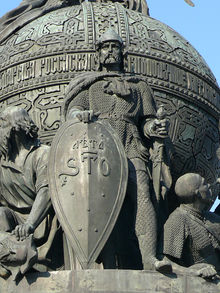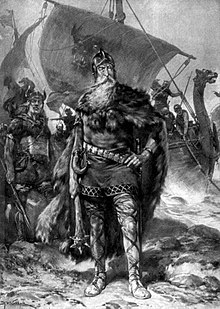Rurik
| Rurik | |
|---|---|
| Prince of Novgorod | |
 Rurik on the 19th-century "Millennium of Russia"monument inVeliky Novgorod | |
| Reign | 862–879[a] |
| Successor | Oleg |
| Died | 879[a] Novgorod |
| Issue | Igor |
| Dynasty | Rurik |
| Religion | Norse paganism |
Rurik(also spelledRorik,RiurikorRyurik;[1][2][3][4]Church Slavonic:Рюрикъ,romanized:Rjurikŭ;[5][b]Old Norse:Hrøríkʀ;died 879)[6][7][a]was aVarangianchieftain of theRus'who, according to tradition, was invited to reign inNovgorodin the year 862.[1][10]ThePrimary Chroniclestates that Rurik was succeeded by his kinsmanOlegwho was regent for his infant sonIgor.
Traditionally, Rurik has been considered the founder of theRurik dynasty,which was the ruling dynasty ofKievan Rus'and its principalities, and ultimately theTsardom of Russia,until the death ofFeodor Iin 1598.
Life
The earliest mention of Rurik is contained in thePrimary Chronicle,traditionally ascribed toNestorand compiled inc. 1113,[11]which states thatEast SlavicandFinnictribes in 860–862 (including theChuds,Slovenes,Krivichs,MeryansandVes) "drove the Varangians back beyond the sea, refused to pay them tribute, and set out to govern themselves".[12]Afterwards the tribes started fighting each other and decided to invite the Varangians, led by Rurik, to reestablish order. Rurik came along with his younger brothersSineus and Truvorand a large retinue.[1]
According to the chronicle, Rurik was one of theRus',aVarangiantribe. Most historians believe that the Rus' were of Scandinavian origin,[13]more specifically from what is currently coastaleastern Swedenaround the eighth century.[14]According to the prevalent theory, the nameRus'is derived from anOld Norseterm for "the men who row", from an older name for the Swedish coastal area ofRoslagen.[15][16]
Sineus established himself atBeloozero,and Truvor at the town ofIzborsk.Truvor and Sineus died shortly after the establishment of their territories,[17][18]and Rurik consolidated these lands into his own territory, extending his rule in northern Russia.[1]Askold and Dir,followers of Rurik who were sent toConstantinople,seizedKievbefore launching anattackrecorded in Byzantine sources for the year 860.[19][17]
TheLaurentian Codexof 1377, which contains the oldest surviving version of thePrimary Chronicle,states that Rurik first settled inNovgorod( "newtown" ), while theHypatian Codexof the 1420s states that Rurik first settled inLadoga,before moving his seat of power to the newly founded city of Novgorod, a fort built not far from the source of theVolkhov River,where he stayed until his death.[18][20][21][22]
Rurik is said to have remained in power until his death some time in the 870s.[a]On his deathbed, Rurik bequeathed his realm toOleg,who belonged to his kin, and entrusted to Oleg's hands his sonIgor,for he was very young. Oleg moved the capital toKiev(by murdering the then-rulers and taking the city) and founded the state ofKievan Rus',which was ruled by Rurik's successors (his son Igor and Igor's descendants). The state persisted until theMongol invasionin 1240.
Legacy
Rurik does not appear in theregnal listin the opening section of theHypatian Codex(compiledc.1425); the list ofknyazi( "princes" ) of Kiev starts with "Dir and Askold",followed by" Oleg ", and then" Igor ".[23]
The Rurikids were the ruling dynasty ofKievan Rus',and ultimately theTsardom of Russia,until 1598, and numerousnoble familiesclaim male-line descent from Rurik. The last Rurikid to rule Russia as tsar wasVasily IV,[24]who reigned until 1610 and was from theHouse of Shuysky.TheRomanovswere also related to the descendants of Rurik through marriage. The descendants of the princely families allegedly inherited from Rurik are still living.[25]
The kingMichał Korybut Wiśniowieckireigned in thePolish–Lithuanian Commonwealthuntil 1673; a member of the House ofWiśniowiecki,who traditionally traced their descent to theGediminids,recent studies side with a Rurikid origin of the House ofZbaraskiand its cadet branches including the House of Wiśniowiecki.[26][27]
Alternative theories

The nameRurikis a form of the Old Norse nameHrœrekr.[28]Rorik of Dorestad was a member of one of two competing families reported by theFrankishchroniclers as having ruled the nascent Danish kingdom atHedeby.He may have been a nephew of kingHarald Klak.He is mentioned as receiving lands inFrieslandfromEmperor Louis I.He plundered neighbouring lands: he tookDorestadin 850, attacked Hedeby in 857, and lootedBremenin 859, while his own lands were ravaged in his absence. The Emperor was enraged and stripped him of all his possessions in 860. After that, Rorik disappears from western sources for a considerable period of time. In 862, according to Russian sources, Rurik arrived in the eastern Baltic and built the fortress of Ladoga. Later he moved to Novgorod.[citation needed]
Rorik of Dorestad reappeared in Frankish chronicles in 870, when his Frieslanddemesnewas returned to him byCharles the Bald.In 882, Rorik is mentioned as dead (without a specific date of death).[citation needed]ThePrimary Chronicleplaces the death of Rurik of Novgorod in 879,[29]three years earlier than the Frankish chronicles. According to western sources, the ruler of Friesland was converted to Christianity by the Franks.[citation needed]
The idea of identifying Rurik of Rus' with Rorik of Dorestad was revived by the anti-NormanistsBoris Rybakovand Anatoly H. Kirpichnikov in the mid-20th century,[30]butAlexander Nazarenkoand other scholars have objected to it.[31]
Gallery
-
Image of Rurik in the "Tsar's titularnik" (1672)
-
Rurik and his brothersSineus and Truvorarrive at Ladoga. Painted byViktor Vasnetsov(c.1913)
Notes
References
- ^abcdThe Oxford illustrated history of the Vikings.Oxford [England]: Oxford University Press. 1997. pp. 138–139.ISBN9780192854346.
- Ketola, Kari; Vihavainen, Timo (2014).Changing Russia?: history, culture and business(1. ed.). Helsinki: Finemor. p. 1.ISBN978-9527124017.
- Dixon-Kennedy, Mike (1998).Encyclopedia of Russian & Slavic myth and legend.Santa Barbara, Calif.: ABC-CLIO. p. 232.ISBN9781576070635.
- ^Obolensky, Dmitri (1990).The Russian chronicles: a thousand years that changed the world: from the beginnings of the Land of Rus to the new revolution of Glasnost today.London: Century. p. 32.ISBN9780712637640.
- ^Harris, Zena and Ryan, Nonna (2004)."The Inconsistencies of History: Vikings And Rurik".New Zealand Slavonic Journal.38:105–130.ISSN0028-8683.JSTOR40922182.Archivedfrom the original on 3 December 2021.Retrieved3 December2021.
- ^Lotha, Gloria."Rurik | Norse leader | Britannica".britannica.com.Archivedfrom the original on 11 October 2014.Retrieved9 March2023.
- ^Клосс, Борис (15 May 2022).Полное собрание русских летописей. Том 1. Лаврентьевская летопись(in Russian). Litres. pp. 19–20.ISBN978-5-04-107383-1.Archivedfrom the original on 23 July 2023.Retrieved21 July2023.
- ^Franklin, Simon and Shepard, Jonathan (6 June 2014).The Emergence of Russia 750-1200.Routledge. p. 57.ISBN978-1-317-87224-5.
- ^Jakobsson, Sverrir (14 October 2020).The Varangians: In God's Holy Fire.Springer Nature. p. 64.ISBN978-3-030-53797-5.
- ^Ostrowski 2018,p. 46.
- ^Ostrowski 2018,p. 42.
- ^Perrie, Maureen (2006).The Cambridge History of Russia. Volume 1. From Early Rus' to 1689.Cambridge: Cambridge University Press. pp. 2, 47–48.ISBN1107639425.
- ^Langer, Lawrence N. (2021).Historical dictionary of medieval Russia(Second ed.). Lanham. p. 145.ISBN9781538119426.
{{cite book}}:CS1 maint: location missing publisher (link) - ^Mägi, Marika (2018).In Austrvegr.Boston: BRILL. p. 207.ISBN9789004363816.
- ^Wickham, Chris (2016).Medieval Europe.New Haven. p. 175.ISBN9780300208344.
{{cite book}}:CS1 maint: location missing publisher (link)- Jones, Gwyn (1984).A history of the Vikings(Revised ed.). Oxford. p. 246.ISBN9780192801340.
{{cite book}}:CS1 maint: location missing publisher (link)
- Jones, Gwyn (1984).A history of the Vikings(Revised ed.). Oxford. p. 246.ISBN9780192801340.
- ^"The Vikings at home".History Extra.24 September 2012.Archivedfrom the original on 4 May 2020.Retrieved26 February2021.
- Mark, Joshua J. (3 December 2018)."Kievan Rus".World History Encyclopedia.Archivedfrom the original on 14 April 2021.Retrieved23 April2021.
- Sorabella, Jean (October 2002).Heilbrunn Timeline of Art History: The Vikings (780–1100).New York: Metropolitan Museum of Art.Archivedfrom the original on 23 April 2020.Retrieved26 February2021.
- ^Blöndal, Sigfús (1978).The Varangians of Byzantium.Cambridge University Press. p. 1.ISBN9780521035521.Archivedfrom the original on 14 April 2023.Retrieved2 February2014.
- ^Brink, Stefan. "Who were the Vikings?', inThe Viking WorldArchived14 April 2023 at theWayback Machine,ed. by Stefan Brink and Neil Price (Abingdon: Routledge, 2008), pp. 4–10 (pp. 6–7).
- ^abLanger, Lawrence N. (2021).Historical dictionary of medieval Russia(Second ed.). Lanham. p. 176.ISBN9781538119426.
{{cite book}}:CS1 maint: location missing publisher (link) - ^abDixon-Kennedy, Mike (1998).Encyclopedia of Russian & Slavic myth and legend.Santa Barbara, Calif.: ABC-CLIO. p. 232.ISBN9781576070635.
- ^Duczko, Wladyslaw (2004).Viking Rus: studies on the presence of Scandinavians in Eastern Europe.Leiden: Brill. p. 204.ISBN9789004138742.
- ^The Cambridge history of Russian literature(Rev. ed.). Cambridge: Cambridge University Press. 1992. pp. 12–13.ISBN9780521425674.
- ^Jones, Gwyn (1984).A history of the Vikings(Revised ed.). Oxford. p. 246.ISBN9780192801340.
{{cite book}}:CS1 maint: location missing publisher (link) - ^Somerville, Angus A.; Mcdonald, Andrew R. (2020).The Viking age: a reader(Third ed.). Toronto. p. 282.ISBN9781487570477.
{{cite book}}:CS1 maint: location missing publisher (link) - ^Ostrowski 2018,p. 36.
- ^Raffensperger, Christian and Ingham, Norman W.. "Rurik and the First Rurikids",The American Genealogist,82 (2007), 1–13, 111–119.
- ^Kalmistopiiri, julkaissut (27 October 2021)."Ruhtinas ja ruhtinaan pojat – paljastavatko geenit Venäjän perustajana pidetyn Rurikin alkuperän?".KALMISTOPIIRI(in Finnish).Archivedfrom the original on 26 September 2022.Retrieved3 September2022.
- ^Księstwa Rzeczpospolitej: państwo magnackie jako region polityczny
- ^Кралюк, Петро (4 April 2020).Півтори тисячі років разом - Спільна історія українців і тюркських народів(in Ukrainian). Glagoslav Publications.ISBN978-966-03-8155-1.
- ^Omeljan Pritsak, "Rus'",inMedieval Scandinavia: An EncyclopediaArchived26 April 2023 at theWayback Machine,ed. Phillip Pulsiano (New York: Garland, 1993), pp. 555–56.
- ^Ostrowski 2018,p. 40.
- ^Kirpichnikov, Anatoly H. "Сказание о призвании варягов. Анализ и возможности источника".Первые скандинавские чтения,СПб; 1997; ch. 7–18.
- ^Nazarenko, Alexander. "Rjurik и Riis Th., Rorik",Lexikon des Mittelalters,VII; Munich, 1995; pp. 880, 1026.
Bibliography
- Halperin, Charles J. (2022).The Rise and Demise of the Myth of the Rus' Land(PDF).Leeds: Arc Humanities Press. p. 107.ISBN9781802700565.Retrieved1 February2023.
- Ostrowski, Donald (2018)."Was There a Riurikid Dynasty in Early Rus'?".Canadian-American Slavic Studies.52(1): 30–49.doi:10.1163/22102396-05201009.



